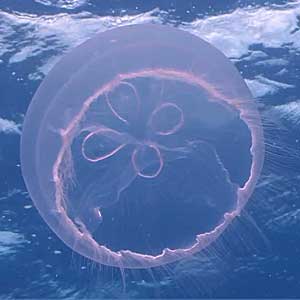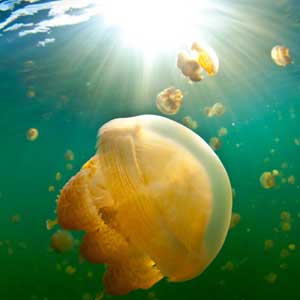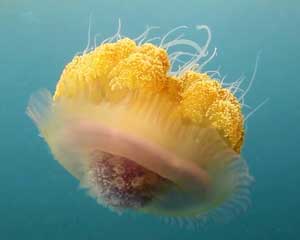Facts about Jellyfish
Posted by Admin / in Science Facts

Jellyfish Facts - Nearly invisible Moon Jellyfish
Important Jellyfish Facts
- Jellyfish are invertebrates meaning they do not have a backbone. In fact, jellyfish have no bones at all, instead they have layers of cells that make up the walls our their flexible outer shape. Inside jellyfish contain jelly, which is made up of salt protein and mostly water.
- Jellyfish are not really fish. They are a type of animal known as a Cnidarian. All Cnidarians have stinging cells. Other Cnidarians include coral and sea anemones.
- A jellyfish is made up of 95 percent water. A jellyfish's jelly, which is mostly water, helps them hold their position in water without spending much energy.
- Jellyfish grow from eggs. Many jellyfish eggs are stored on the underside of their body. When the jellyfish hatch, they cling to rock or other objects on the bottom of the ocean. Hatched jellyfish are known as polyps. Polyps grow and eventually float away, like other full-grown jellyfish.
- Most jellyfish live near the surface of the ocean. Some jellyfish drop to deeper waters during the day and return near the surface a night to find food. Other jellyfish do the opposite. They spend their days finding food near the surface and drop to deeper water during the night. Some jellyfish live at extreme depths of the oceans all the time. Their flexible bodies allow them to live under a great amount of water pressure and survive without harm.
- Once thought to only float with the ocean's currents and tides, scientists are now finding evidence that jellyfish can swim against the ocean currents.
- Jellyfish can only survive in saltwater. Although there are jellyfish found in brackish intercoastal waters, there are no known jellyfish that can survive pure freshwater.
- Although some jellyfish live alone, a majority of jellyfish are found in groups known as shoals or swarms. Extremely large gatherings of hundreds of thousands or even millions of jellfish are known as blooms.
- Jellyfish generally eat zooplankton, which are tiny marine animals. Jellyfish take in zooplankton in the water as they move through the ocean.
- Jellyfish are capable of eating larger sea animals like fish and shrimp. Jellyfish use their stingers to stun the fish and shrimp. They then use their oral arms to move their prey into their mouth.

These jellyfish are feeding at the ocean surface
Parts of a Jellyfish
- Jellyfish are very simple animals. They have no brain or heart.
- Jellyfish have no gills or lungs.
- Jellyfish have an umbrella-shaped body. They move around by opening and closing this umbrella shape with a muscle. Water pressure shooting out the bottom of the umbrella pushed the jellyfish through the water, although very slowly.
- Jellyfish also have oral arms that help them eat.
- Jellyfish have tentacles that hang on the bottom of the their body and on the bottom outside edge of their umbrella. Their tentables contain the stinging cells.
- Jellyfish have a stomach inside their body.
- Jellyfish also have a mouth which is the only path to their stomach. Their digestive system is very simple.
- Jellyfish do not have eyes or most senses like people. Instead jellyfish have sensing cells that help them gather information from the water around them. Jellyfish can sense water pressure, changes in water chemistry and light. They also have sensing cells that help them to know which way is the direction to the surface of the water.

Jellyfish live in saltwater
Interesting Jellyfish Facts
- Jellyfish begin as an egg. They continue to grow until they die.
- Scientists are not sure why, but sea slugs, ocean sunfish and leatherback sea turtles are immune to jellyfish sting. The main diet of a leatherback sea turtle is jellyfish.
- Several types of jellyfish, including the sea nettle, can make their own light.
- The most poisionous jellyfish are the Australian sea wasp and Chrionex fleckeri (type of box jellyfish), which have a sting more toxic than the deadliest snake venom. People can be killed in as little as 3 minutes after being stung type either of these two types of jellyfish. Amazingly, leatherback turtles can eat these type of jellyfish and not be harmed.
- Stinging cells on a jellyfish body can still sting even after the jellyfish dies. A jellyfish that is washed up on a beach can be just as dangerous as one in the ocean.
- Tentacles on a lion's mane jellyfish can reach a length of 100 feet. Blue whales, the largest animal on earth grow to a length up to 110 feet.
- Jellyfish are thought to be relatively immune to pollution in the ocean. Scientists track polluted dead zones in the ocean where most animals cannot survive. They only animals found there are typically jellyfish.
